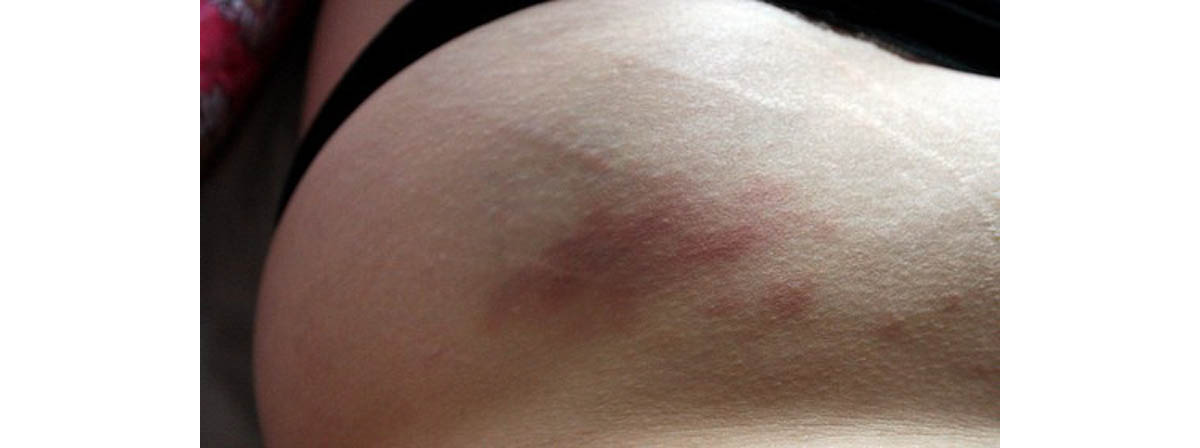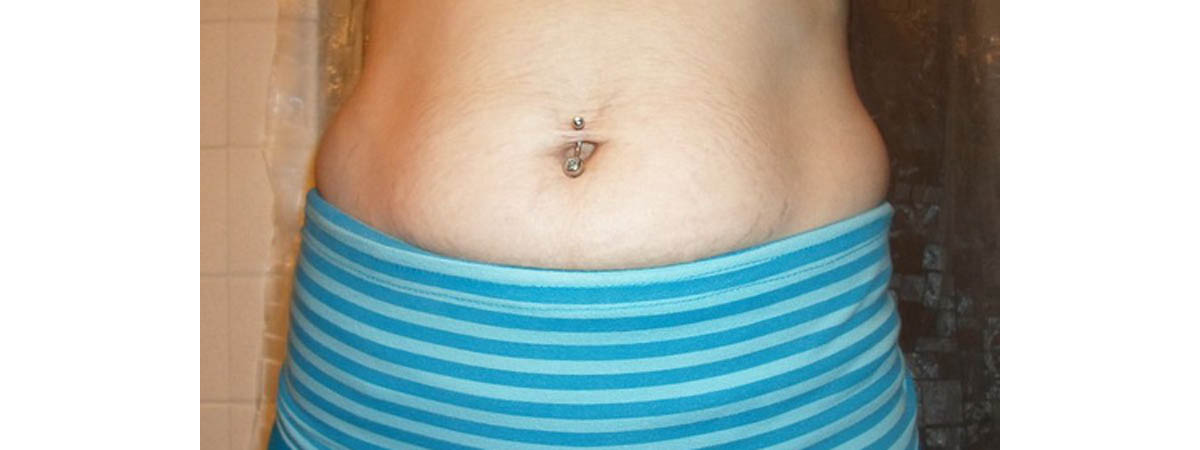Stretch marks first appear when the skin is literally stretched very quickly over a short period of time. Most commonly, stretch marks appear in the later stages of pregnancy, when a person gains a lot of weight or during puberty.

Stretch marks are also more common in those with a history of stretch marks in the family, in those with certain health conditions such as Marfan Syndrome, and in those who use corticosteroid medication.
Why Do Stretch Marks Appear?
The dermis is usually very strong, made up of lots of fibers that are all interconnected. These fibers are designed to accommodate growth and usually, they can expand. When growth occurs very quickly - or when the skin is more prone to breakage due to pregnancy hormones or a medical condition - these fibers can snap apart. This means that when the fibers break, tears appear in the skin, which means that the deeper layers of skin and blood vessels can be seen beneath the surface of the stretch marks.
Over time, when the blood vessels underneath the skin contract and shrink, the layer of fat beneath the skin can be seen instead - and this is why older stretch marks tend to be silvery/white.
How Can I Reduce the Risk of Stretch Marks?
Although that's not good news if you already have stretch marks, luckily, you can help to prevent further stretch marks by making a few lifestyle changes. Eat a wide range of fruits and vegetables in lots of different colors - the wider the range of color, the wider the range of nutrients. These nutrients will keep you healthy and will improve the suppleness of your skin.
It's also a good idea to include plenty of omega-3s in your diet, from sources like oily fish, nuts and seeds, as this could improve skin texture. Above all, try not to gain weight too quickly. If you do need to gain weight, be sure to do it slowly under the supervision of your doctor.
Losing weight too quickly doing a crash diet means that you're more likely to pile it back on again - and yo-yo dieting is a leading cause of stretch marks and sagging skin.
How Can I Minimize The Appearance Of Stretch Marks?
Luckily, there are some things you can do to minimize the appearance of stretch marks. The main thing you need to do is moisturize, moisturize, moisturize.

Look for products that contain shea butter or cocoa butter as a base as these are incredibly nourishing and use your fingertips to massage the moisturizer into skin so that it can get to work on the deeper layers of skin.
Take Vitamin C
Vitamin C is thought to improve the suppleness of skin and it could even increase collagen production, improving the elasticity of skin. The more elastic the skin, the less likely it is that stretch marks will appear. If you start taking a vitamin C supplement when your stretch marks are in the early stages, they could fade and turn silvery-white more quickly. Leslie Baumann, author of The Skin Type Solution recommends taking 500mg of Vitamin C three times a day. Some experts also advise crushing a vitamin C capsule into your regular moisturizer so that the vitamin C can get to work on the skin from the outside in.
Retinoids and Glycolic Acid
Retinoids are thought to be effective because they increase collagen production, evening out the texture of skin, preventing further tears and increasing suppleness. You shouldn't use retinoids if you're pregnant and generally, they won't be effective on old stretch marks.
Glycolic acid is another topical solution, in the same family of treatments as chemical peels, also thought to increase the production of collagen. For the best results, use retinoids and glycolic acid alongside vitamin C supplements.
Vitamin E Oil
Widely touted as the "miracle cure", vitamin E oil has long been used to fade the appearance of stretch marks. However, one study found that vitamin E oil is most effective in women who are pregnant, and this is possibly due to the interaction of the vitamin E with the hormones that occur during pregnancy. Still, it can't hurt to try - use your vitamin E oil with a carrier cream, oil or moisturizer.
Laser Treatment
Laser treatment is thought to be one of the most effective non-invasive stretch mark treatments. Laser light is guided by a dermatologist or surgeon over the stretch marks, where it damages the stretch marks, encouraging the growth of new, stretch mark-free skin over the following 12 months. It can be painful, and it can be pricey, but if you've tried everything else but don't want to go under the knife, laser treatment might well be your best option.
Stretch marks can be tricky to minimize. But with the right mix of treatments and the right lifestyle, you can reduce their appearance.
- Photo courtesy of Natalia Balcerska by Flickr : www.flickr.com/photos/harry_manback/4798142781/
- Photo courtesy of ParentingPatch by Wikimedia Commons : commons.wikimedia.org/wiki/File:Female_Torso_with_Tiger_Stripes_(Stretch_Marks)_from_Pregnancy.JPG


Your thoughts on this